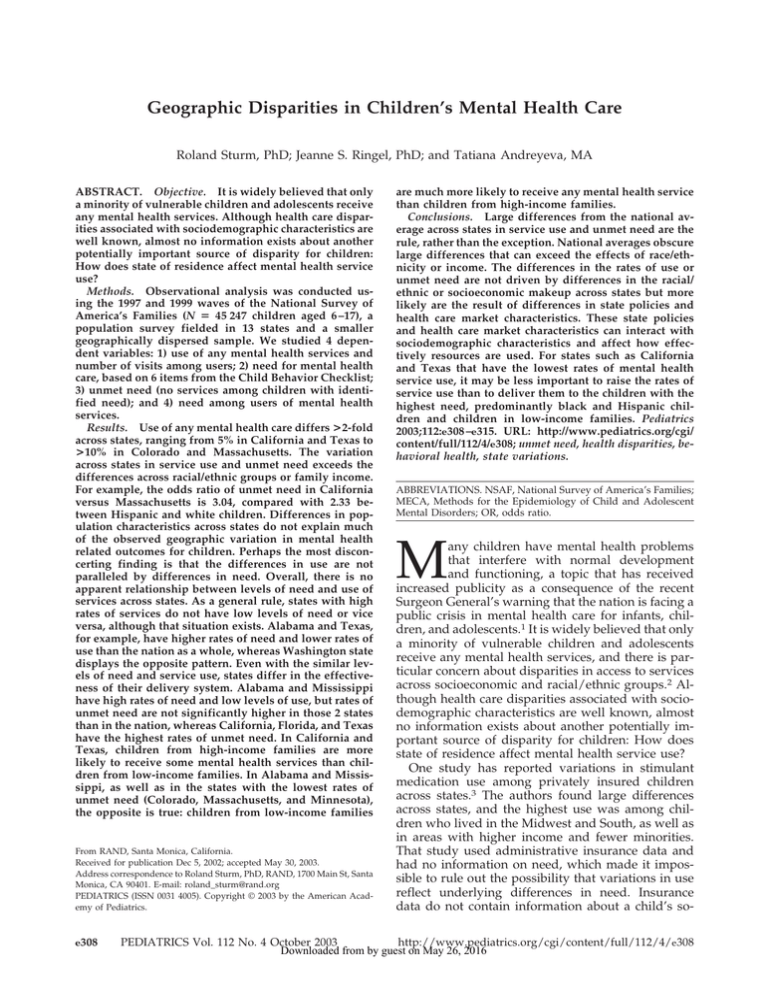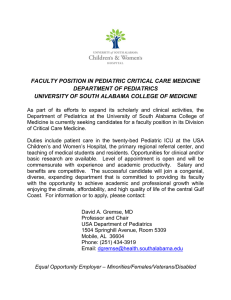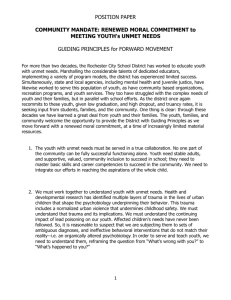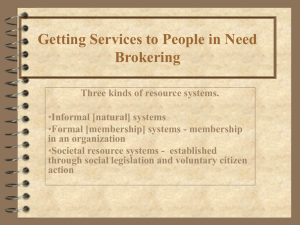
Geographic Disparities in Children’s Mental Health Care
Roland Sturm, PhD; Jeanne S. Ringel, PhD; and Tatiana Andreyeva, MA
ABSTRACT. Objective. It is widely believed that only
a minority of vulnerable children and adolescents receive
any mental health services. Although health care disparities associated with sociodemographic characteristics are
well known, almost no information exists about another
potentially important source of disparity for children:
How does state of residence affect mental health service
use?
Methods. Observational analysis was conducted using the 1997 and 1999 waves of the National Survey of
America’s Families (N ⴝ 45 247 children aged 6 –17), a
population survey fielded in 13 states and a smaller
geographically dispersed sample. We studied 4 dependent variables: 1) use of any mental health services and
number of visits among users; 2) need for mental health
care, based on 6 items from the Child Behavior Checklist;
3) unmet need (no services among children with identified need); and 4) need among users of mental health
services.
Results. Use of any mental health care differs >2-fold
across states, ranging from 5% in California and Texas to
>10% in Colorado and Massachusetts. The variation
across states in service use and unmet need exceeds the
differences across racial/ethnic groups or family income.
For example, the odds ratio of unmet need in California
versus Massachusetts is 3.04, compared with 2.33 between Hispanic and white children. Differences in population characteristics across states do not explain much
of the observed geographic variation in mental health
related outcomes for children. Perhaps the most disconcerting finding is that the differences in use are not
paralleled by differences in need. Overall, there is no
apparent relationship between levels of need and use of
services across states. As a general rule, states with high
rates of services do not have low levels of need or vice
versa, although that situation exists. Alabama and Texas,
for example, have higher rates of need and lower rates of
use than the nation as a whole, whereas Washington state
displays the opposite pattern. Even with the similar levels of need and service use, states differ in the effectiveness of their delivery system. Alabama and Mississippi
have high rates of need and low levels of use, but rates of
unmet need are not significantly higher in those 2 states
than in the nation, whereas California, Florida, and Texas
have the highest rates of unmet need. In California and
Texas, children from high-income families are more
likely to receive some mental health services than children from low-income families. In Alabama and Mississippi, as well as in the states with the lowest rates of
unmet need (Colorado, Massachusetts, and Minnesota),
the opposite is true: children from low-income families
From RAND, Santa Monica, California.
Received for publication Dec 5, 2002; accepted May 30, 2003.
Address correspondence to Roland Sturm, PhD, RAND, 1700 Main St, Santa
Monica, CA 90401. E-mail: roland_sturm@rand.org
PEDIATRICS (ISSN 0031 4005). Copyright © 2003 by the American Academy of Pediatrics.
e308
are much more likely to receive any mental health service
than children from high-income families.
Conclusions. Large differences from the national average across states in service use and unmet need are the
rule, rather than the exception. National averages obscure
large differences that can exceed the effects of race/ethnicity or income. The differences in the rates of use or
unmet need are not driven by differences in the racial/
ethnic or socioeconomic makeup across states but more
likely are the result of differences in state policies and
health care market characteristics. These state policies
and health care market characteristics can interact with
sociodemographic characteristics and affect how effectively resources are used. For states such as California
and Texas that have the lowest rates of mental health
service use, it may be less important to raise the rates of
service use than to deliver them to the children with the
highest need, predominantly black and Hispanic children and children in low-income families. Pediatrics
2003;112:e308 –e315. URL: http://www.pediatrics.org/cgi/
content/full/112/4/e308; unmet need, health disparities, behavioral health, state variations.
ABBREVIATIONS. NSAF, National Survey of America’s Families;
MECA, Methods for the Epidemiology of Child and Adolescent
Mental Disorders; OR, odds ratio.
M
any children have mental health problems
that interfere with normal development
and functioning, a topic that has received
increased publicity as a consequence of the recent
Surgeon General’s warning that the nation is facing a
public crisis in mental health care for infants, children, and adolescents.1 It is widely believed that only
a minority of vulnerable children and adolescents
receive any mental health services, and there is particular concern about disparities in access to services
across socioeconomic and racial/ethnic groups.2 Although health care disparities associated with sociodemographic characteristics are well known, almost
no information exists about another potentially important source of disparity for children: How does
state of residence affect mental health service use?
One study has reported variations in stimulant
medication use among privately insured children
across states.3 The authors found large differences
across states, and the highest use was among children who lived in the Midwest and South, as well as
in areas with higher income and fewer minorities.
That study used administrative insurance data and
had no information on need, which made it impossible to rule out the possibility that variations in use
reflect underlying differences in need. Insurance
data do not contain information about a child’s so-
PEDIATRICS Vol. 112 No. 4 October 2003
http://www.pediatrics.org/cgi/content/full/112/4/e308
Downloaded from by guest on May 26, 2016
ciodemographic characteristics (other than age and
sex of the insured family members), and these are
important factors regarding mental health care that
we want to study. Earlier studies limited to smaller
geographic areas (Maryland and Michigan) have established variation in psychotropic medication use
across areas as well but also highlighted racial/ethnic disparities.4 – 6 Among Medicaid children in
Maryland, white children were twice as likely to
receive psychotropic medication as black children;
the effect of race was stronger for psychotropic than
for nonpsychotropic medication.5 Two studies provided national estimates of service use and need but
did not analyze geographic variations.7,8 Both studies found that the majority of children who need a
mental health evaluation do not receive services and
that unmet need varies across socioeconomic and
racial/ethnic groups.
These findings raise several questions that we
want to address in this article. First, could it be that
geographic variations reflect differences in need?
The medication studies had no information on need,
but if state variations in service use parallel underlying differences in need, then there should be much
less concern about geographic variations. Second, do
geographic variations in service use reflect population characteristics (and therefore socioeconomic disparities in health care), or do they reflect state characteristics independent of population characteristics?
This article tries to answer these questions using
data from 2 waves from the National Survey of
America’s Families (NSAF). The NSAF data are
unique because the sampling strategy of this survey
allows for both state-level estimates for 13 states and
nationally representative estimates. The 13 focus
states in the NSAF were chosen because they collectively accounted for more than one half of the US
population and varied in terms of geographic location, size, demographics, and dominant political tradition.9 No other databases that could generate similar estimates of mental health service need and use
among children exist. Although there have been several large national studies on mental health care for
adults, only a pilot project, the 1992 National Institute of Mental Health Methods for the Epidemiology
of Child and Adolescent Mental Disorders (MECA)
Study, has been fielded for children. The MECA
study was limited to 4 locations, and the sample size
was too small for site estimates (⬍1500 observations
total) and was not nationally representative.10,11 In
addition, the data collection preceded the dramatic
growth of carve-outs, the mental health parity debate, and the increased awareness in the general
public that efficacious treatments for mental health
TABLE 1.
disorders are available. The National Health Interview Survey covers similar questions as the NSAF,
but state- or site-level estimates are not possible because of the geographic dispersion and the absence
of geographic identifiers in available data.
METHODS
The primary data used in this article are from the Urban Institute’s NSAF.12 The survey has 2 rounds, fielded in 1997 and 1999.
We tested for changes in use of mental health services or need for
services between the 2 time periods, but statistical tests showed no
significant changes in use or need over time. We therefore pooled
the 2 rounds of data in each survey to increase the sample size of
children and adolescents using mental health services.
State-specific estimates are possible for 13 focus states; nationally representative numbers are based on weighted data from
those 13 states plus the sample from the balance of the United
States. (The focus states in the NSAF are Alabama, California,
Colorado, Florida, Massachusetts, Michigan, Minnesota, Mississippi, New Jersey, New York, Texas, Washington, and Wisconsin.)
After excluding observations with missing values, our analysis
sample includes 45 247 children aged 6 to 17 with 40 112 of those
children in the 13 focus states.
Use of Mental Health Services
We used 2 variables to measure the use of mental health services: an indicator of any use of services and the number of visits
among children with at least 1 visit. Any use means that the parent
reported that the child has received mental health services on 1 or
more occasions. The exact wording of the question is as follows:
“During the past 12 months, how many times has [child] received
mental health services, including mental health services received
from a doctor, mental health counselor, or therapist? (and do not
include treatment for substance abuse or smoking cessation)
Need for Mental Health Services
For children aged 6 to 17, the NSAF provides a measure of
mental health need that is based on parental responses to 6 items
from the Child Behavior Checklist. The parent is asked to report
how often the items in Table 1 are true about their child.
Each question is scored on a scale of 1 to 3, with 1 representing
“often true,” 2 representing “sometimes true,” and 3 indicating
that it is “never true” about their child. The negative behavior
problem index is created in the NSAF by summing the scores for
the 6 appropriate questions for each child. Thus, the values of the
index range from a low of 6 to a high of 18, with higher values
indicating fewer problems. A score of 12 or less is considered an
indicator of high emotional and behavioral problems. The level of
missing data for this measure is low, the spread around the mean
for both age groups is sufficient, and the percentages of children
with high levels of behavioral problems vary in the expected
direction depending on families’ socioeconomic circumstances.13
The ␣ on the 2 scales are moderately high, 0.73 for the scale used
for the children aged 6 to 11 and 0.75 for the scale used for children
aged 12 to 17.13 More details about the selection of items, the
choice of the cutpoint to dichotomize the scale, construct validity,
and benchmarking against other surveys are available in the
NSAF documentation.13
Two important limitations of this measure are that the scale is
based on a reduced set of questions and therefore less reliable than
the full Child Behavior Checklist and that only parent responses
are available. The smaller number of items will miss more children
with serious problems than the full set of questions but can also
Questions in the NSAF Used To Measure Mental Health Need
I am going to read a list of items that sometimes describe children. For each item, please tell me if it has been often true, sometimes true,
or never true for the child during the past month.
All Children
Only 6- to 11-Year-Olds
Only 12- to 17-Year-Olds
Does not get along with other kids
Cannot concentrate or pay attention for long
Has been unhappy, sad, or depressed
Feels worthless or inferior
Has been nervous high-strung, or tense
Acts too young for his/her age
Has trouble sleeping
Lies or cheats
Does poorly at schoolwork
http://www.pediatrics.org/cgi/content/full/112/4/e308
Downloaded from by guest on May 26, 2016
e309
incorrectly classify some children as having need. This would be a
problem for clinical studies, but a reliable assessment of the clinical status of a particular child is not as important for an epidemiologic comparison. In general, assessments of mental health
problems are more sensitive when they include both parent and
child information.14 In particular, research has shown that parents
and children often disagree on the presence of diagnostic conditions.15 Having only parental reports suggests that the measure of
mental health need in the NSAF will be better able to detect
externalizing conditions, which are more reliably detected by
parent report, than internalizing conditions, such as depression,
that tend to be more dependent on interviews of children for
diagnosis.
Choosing how to dichotomize a continuous scale is always
somewhat arbitrary. Ideally, one would choose a cutpoint to
match the prevalence based on a “gold standard” measure of
need, but no such measure or national estimate exists: in the
National Institute of Mental Health MECA study, prevalence estimates ranged from 5% to 50%, and there is no agreement on the
“true” number.10 Prevalence estimates based on pediatric primary
care diagnosis tend to be in the 5% range and lower than estimates
based on parent interview.16 The recommended cutpoint for the
NSAF will result in a prevalence at the lower end of that range
(7.1%), which is advantageous because we will identify only children who are more symptomatic and likely to benefit from receiving some care.13 With a higher cutpoint (fewer behavioral problems), more children with minor symptoms would be classified as
needing care, yet many of those children would not benefit from
care and are not receiving any. A recent article created a separate
scale that uses only 4 of the 6 items in the NSAF, and a less
stringent cutpoint reports a much higher prevalence of need
(20.8%).7
Unmet Need for Mental Health Services
We generate a measure of unmet need for mental health services by combining the indicators of any use and need. Although
this variable at face value seems to be of major policy interest, the
limitations of the need measure are likely to bias its absolute level.
For example, as long as the assessment of need is not perfectly
specific, children without need are incorrectly classified as having
need, but because they are healthy, those children will not use
services and therefore are misclassified as having “unmet need.”
This will inflate the estimates of unmet need, although the relatively stringent cutpoint in the NSAF reduces this problem. Given
the limitations of the measures, the rate of “unmet need” is probably best interpreted as shorthand for “percentage of children who
are sufficiently symptomatic to warrant at least a psychological
evaluation but who have not received either an evaluation or
mental health care in past 12 months.”
Need Among Users of Mental Health Services
Another way to examine need is to focus only on those children
who used mental health services. Together with unmet need
(which focuses only on children with need), it will provide a
picture of how well resources are targeted to the most needy
children. States could have exactly the same levels of need and
utilization of services per capita but nevertheless could differ on
rates of unmet need and need among users. We would consider
the state with lower unmet need and higher need among users to
have the more efficient system. To calculate need among users, we
want to change the definition of use and consider only children
who have had at least 3 visits for mental health reasons. The
reason to exclude children with just 1 or 2 visits is that more
widespread screening of children for mental health problems may
be a good idea and in fact help to target resources better. Most of
those children would not be expected to have substantial symptoms. In contrast, children who receive a more meaningful amount
of mental health services should have substantial symptoms, especially when there are much more symptomatic children who
receive no services at all. This measure has similar limitations to
those associated with the measure of unmet need. Some children
receiving care may have serious problems not captured by the
need items in the survey, especially internalizing problems of
which parents may not be aware, so we do not want to interpret
this as an estimate of overuse. However, in combination of unmet
need estimates, it provides an idea of how states are comparing in
their ability to target resources to more vulnerable children.
The results reported here are primarily descriptive. For accounting for oversampling and to adjust for differences as a result
of nonresponse, a sampling weight, calculated as the inverse of the
probability of selection and response, is used to make inferences
representative of the particular group of interest (eg, state, nation).
Also, t tests are used to compare state estimates with the national
average.
When adjusting for demographic and socioeconomic population differences to test the robustness of the results and determine
the role of individual characteristics, we use logistic and linear
regression models. Explanatory variables include race/ethnicity
of the child, age group, insurance status, and family income at the
individual level and state dummy variables (fixed effects). The
tests for differences across states in models that control for individual characteristics are based on logistic models when the dependent variable is dichotomous (report z statistic) and linear
models when the dependent variable is continuous (report t statistic). We discuss the adjusted results and highlight in the text
when controlling for such characteristics changes the descriptive
results but show no separate regression results.
RESULTS
Use of Mental Health Services
There are large differences across states that are
not explained by sociodemographic characteristics.
State effects on utilization exceed the effect of race/
ethnicity or income. Figure 1 shows how the use of
any mental health care differs across states, ranging
from 5.1% in California to 11.6% in Massachusetts.
Fig 1. Geographic variation in use of
mental health services for school-age
children in the NSAF states.
e310
GEOGRAPHIC DISPARITIES IN CHILDREN⬘S MENTAL HEALTH CARE
Downloaded from by guest on May 26, 2016
Five of the 13 states (California, Colorado, Massachusetts, Minnesota, and Texas) are significantly different from the national average of 7.5% at conventional
levels (P ⱕ .05), and 2 additional states (Alabama and
Florida) are significantly different at P ⬍ .10. Thus,
large differences from the national average across
states are the rule, rather than the exception, and
focusing on national averages obscures large differences across states. Additional details from this analysis are presented in Table 2. The third column of
estimates in Table 2 provides the intensity of use
among children and adolescents receiving any service (no graphic representation). One would expect
that, as the percentage of children receiving services
increases, less symptomatic children receive some
care (possibly just an evaluation), and therefore the
intensity of services among users declines in areas
with higher rates of any service use, but this is not
the case—if anything, intensity tends to move more
in parallel with rates of any service use. Several
states with the highest rates of children accessing
care also have the highest intensity of care (eg, 15.7
contacts in Massachusetts), and some states with the
lowest rates of any use also have the lowest intensity
of care among users (eg, 9 contacts in Alabama).
Statistically, the differences across states in intensity
of care among users are reduced relative to any care,
although that is as much a consequence of the much
smaller sample sizes (⬍1/10) than of reduced relative differences. Only 3 states have the average number of visits that is statistically different from the
national average (Massachusetts, Colorado, and
New York).
The variation in service use across states is noticeably wider than the variation across racial/ethnic
groups (Table 3), which ranges from 5.3% among
Hispanic children to 8.4% among black children.
Only Hispanic children are significantly different
from the national average. In terms of intensity of
care (visits among users), there is little difference
among white, black, and Hispanic children, although
children in other racial groups have significantly
fewer visits when they use any services.
TABLE 2.
Although utilization follows a clear (and statistically significant) gradient with lower use among children in higher income families, the absolute change
between the lowest and highest income groups is
smaller than among the top and bottom third of the
states (Table 4). There are no noticeable differences in
intensity of care by income group.
We tested whether the observed state differences
in mental health-related outcomes are generated by
demographic differences across states. Adjusting for
age, race/ethnicity, insurance status, and family income (based on a logistic regression for any use and
a linear regression with log visits as the dependent
variable for intensity) does not change the ranking of
the states or reduce the magnitudes of differences
across states very much (data not shown). One of the
largest changes after adjustment can be seen in the
odds ratio (OR) for any use comparing Massachusetts with California. The OR based on the descriptive results in Table 2 is 2.41 and falls to 2.06 when
the estimates are adjusted for individual characteristics. Other ORs are even less sensitive to adjustments
for compositional differences. For example, the OR of
any use of services in Massachusetts relative to Alabama is 1.89 based on the descriptive statistics in
Table 2 falls only slightly to 1.79 after adjusting for
sociodemographics. The adjusted differences in service use between states remain noticeably larger than
the biggest race/ethnicity differences. The OR for the
comparison of white, non-Hispanic and Hispanic
children is 1.51 in the descriptive statistics and rises
to 1.64 after adjusting for other individual characteristics and state of residence.
Mental Health Need
Need does not parallel mental health service use
variation across states. Although state effects on utilization are stronger than race/ethnicity or family
income effects, the opposite is true for need. Differences in service use are of little concern if there are
corresponding differences in need, but this is not the
case. The pattern in Fig 2, which displays need estimates, has no relationship with the state patterns in
Use of Mental Health Services and Need
No. of
Observations
Alabama
California
Colorado
Florida
Massachusetts
Michigan
Minnesota
Mississippi
New Jersey
New York
Texas
Washington
Wisconsin
Rest of US
National average
Sample size
2554
2432
3012
2601
3139
2799
3179
2424
3538
2852
2786
3153
5643
5135
45 247
Any Service
No. of Visits
Among Users
Need
Unmet Need
Need Among
Users
6.47*
5.13†
10.06†
6.47*
11.55†
7.65
9.27†
6.58
6.87
8.07
5.69†
7.97
7.96
8.05
7.45
45 247
9.02
11.68
14.92*
12.27
15.71†
11.85
13.51
14.19
11.99
13.56*
10.14
10.89
10.33
10.18
11.15
3777
8.26*
6.34
6.65
8.09
7.05
7.14
7.50
9.43†
5.58†
6.69
7.92
5.92†
7.93*
7.09
7.09
45 247
69.34
80.57†
55.23†
73.73†
51.27†
66.67
54.83†
70.37
62.17
57.29*
76.39†
64.74
64.53
59.67
64.71
3470
47.07*
31.28
32.13
38.33
31.78
40.43
36.06
50.07*
30.34
40.96
37.58
35.74
40.14
37.52
37.11
2642
* Significantly different from national average at P ⬍ .10.
† Significantly different from national average at P ⬍ .05.
http://www.pediatrics.org/cgi/content/full/112/4/e308
Downloaded from by guest on May 26, 2016
e311
TABLE 3.
Use of Mental Health Services and Need by Race/Ethnicity
White
Black
Hispanic
Other
National average
No. of
Observations
Any Service
No. of Visits
Among Users
Need
Unmet
Need
Need Among
Users
31 240
6371
6022
1614
45 247
7.77
8.44
5.29*
6.19
7.45
11.34
10.22
12.77
7.72*
11.15
6.09*
10.59*
7.82
7.14
7.09
59.18*
69.23
77.16*
67.07
64.71
35.66
42.79
38.83
35.27
37.11
* Significantly different from national average at P ⬍ .05.
TABLE 4.
Use of Mental Health Services and Need by Income Group
Low income (⬍150% poverty line)
Middle income (150%–300% poverty line)
High income (⬎300% poverty line)
National average
No. of
Observations
Any Service
No. of Visits
Among Users
Need
Unmet
Need
Need Among
Users
13 240
14 388
17 619
45 247
8.97*
7.47
6.34*
7.45
11.86
11.58
10.02
11.15
11.52*
6.22*
4.55*
7.09
66.60
62.97
63.05
64.71
48.56*
34.04
29.20*
37.11
* Significantly different from national average at P ⬍ .05.
Fig 2. Geographic variation in need
for mental health services for schoolage children in the NSAF states.
Fig 1. Massachusetts had the highest rate of mental
health service use at nearly 12%, but the estimated
need for mental health services among children in
Massachusetts is slightly below the national average
at 7.1%. The opposite is true in Alabama and Mississippi, which have lower rates of any mental health
care than the national average yet higher estimated
rates of need (significant at P ⬍ .05 for Mississippi,
P ⬍ .10 for Alabama). In contrast to the ⬎2-fold
differences in any services use, mental health need
varies less across states, ranging from 5.6% in New
Jersey to a high of 9.4% in Mississippi (Table 2).
Although the national average rates of mental health
need and service use are relatively similar (7.5% with
any use vs 7.1% with need, based on the chosen
indicator), the geographic variations in use ensure
that the mismatch is much larger in almost all states.
In comparison with the national average estimate,
we observe large and statistically significant differences in need for black (10.6%) and white children
(6.1%; P ⬍ .01; Table 3), although they become statistically insignificant when adjusting for family income, insurance status, and state of residence. The
e312
descriptive black/white OR is 1.8 (1.3 in a multivariate model), which is similar to the OR of 1.8 for the
need rates of Mississippi versus New Jersey (1.4 in a
multivariate logistic model). Descriptively, the largest disparities in need are across families with different income levels (Table 4). The OR of children in
low-income families versus those in high-income
families in need is 2.73, exceeding any differences
across states or racial/ethnic groups.
Unmet Need for Mental Health Care
Hispanic children have the highest unmet need,
but geographic disparities in unmet need can exceed
the effect of race/ethnicity. The odds of having unmet need for a child in California are 3 times the
odds of unmet need for a similar child in Massachusetts. The percentage of children identified as having
some need but receiving no services combines the 2
dimensions of use and need. Figure 3 shows the
descriptive rates for unmet need. At the individual
level, the rates of mismatch between (measured)
need and service use are much higher than at the
aggregate, reflecting both a true effect (services are
GEOGRAPHIC DISPARITIES IN CHILDREN⬘S MENTAL HEALTH CARE
Downloaded from by guest on May 26, 2016
Fig 3. Geographic variation in unmet
need for mental health services for
school-age children in the NSAF
states.
not always delivered to individuals who need them
most) and a spurious methods effect (a crude measure of need will incorrectly classify some children).
Across states, the rate of unmet need ranges from a
low of 51.3% in Massachusetts to a high of 80.6% in
California (Table 2). Six of the 13 NSAF states have
rates of unmet need that are statistically different
from the national average at P ⬍ .05 (California,
Florida, and Texas with above-average unmet need;
Colorado, Massachusetts, and Minnesota with below-average unmet need). A surprising finding is
that Mississippi and Alabama, states with high need
and low service use, are not in this group, suggesting
that those 2 states may be more successful in targeting available services to children in need than other
states.
There are no significant differences in unmet need
by income group, although there are significant differences in unmet need across racial/ethnic groups,
especially between Hispanic and white children (OR:
2.33; P ⬍ .01; see Table 2 for absolute rates). There are
also large state variations. For example, the OR for
unmet need in California versus Massachusetts is
3.04 (P ⬍ .01). Multivariate regression analysis reduces the variation across racial/ethnic groups and
states somewhat but does not change the rankings.
Mental Health Need Among Service Users
There is little variation across states or by race/
ethnicity in need among users. However, there is a
very strong income effect: children from high-income families receiving mental health care are much
less likely to have substantial symptoms. There is
little variation across states in need among users, and
we therefore do not show a graph for this variable
(numbers are provided in Table 2). However, 2
states, Alabama and Mississippi, have rates that are
noticeably higher than the national average of 37.1%
(borderline statistically significant, P ⬍ .10). Although we should not overinterpret these findings
because of the limitations of assessed need, we tend
to interpret this as an indicator that services in Mis-
sissippi and Alabama are indeed more targeted to
children who are more symptomatic than in other
states. This may be not unexpected given the lower
resources for mental health services in those states,
combined with similar or even higher need. However, it is not an automatic outcome either, and we
think that these tentative results are a positive and
encouraging finding. At the other extreme is California, the state where the highest rates of unmet need
coexist with the second lowest rate of need among
users. Therefore, state differences exist not only in
the overall rates of service use but also in how effectively services are delivered to the most needy children.
Need among users does not differ across racial/
ethnic groups, but there are big effects of family
income. Children in high-income families receiving
treatment (defined as at least 3 contacts) are much
less likely to display mental health problems than
children in low-income families (OR: 0.44; P ⬍ .05;
Table 4).
DISCUSSION
This study compares mental health need and service use among children and adolescents across 13
US states. It reinforces the growing concern about
health and health care disparities but highlights a
different source of inequity, namely the role of geographic differences. This source of inequity has generally gone unnoticed until now as a result of the
absence of consistent data across a large number of
states.
Regarding the use of any services, the effect of
state of residence exceeds the effects of either race/
ethnicity or income. In contrast, the differences in
need across states are relatively small, especially after adjusting for sociodemographic differences (the
largest OR, Mississippi vs New Jersey, is 1.4). For
need, sociodemographics play a larger role. For example, there are large differences by family income,
with the highest level of need among children in the
poor families.
http://www.pediatrics.org/cgi/content/full/112/4/e308
Downloaded from by guest on May 26, 2016
e313
Perhaps the most disconcerting finding is that the
differences in use across states are not paralleled by
differences in need. Overall, there is no apparent
relationship between levels of need and use of services across states. As a general rule, states with high
rates of services do not have low levels of need or
vice versa, although that situation exists. Alabama
and Texas, for example, have higher rates of need
and lower rates of use than the nation as a whole,
whereas Washington state displays the opposite pattern.
We constructed 2 variables to study how well resources are targeted to the most needy children.
Even with the same levels of need and service use,
states can differ in the effectiveness of their delivery
system, and we see noticeable differences across
states. Alabama and Mississippi have high rates of
need and low levels of use, but rates of unmet need
are not significantly higher in those 2 states than in
the nation. Instead, rates of unmet need are highest
in California, Florida, and Texas. Why do these differences exist? Much of that can be attributed to how
service within state varies by income or race/ethnicity (data not shown). In California and Texas, children from high-income families are more likely to
receive some mental health services than children
from low-income families. In Alabama and Mississippi, as well as in the states with the lowest rates of
unmet need (Colorado, Massachusetts, and Minnesota), the opposite is true: children from low-income
families are much more likely to receive any mental
health services than children from high-income families. Unfortunately, we need much larger sample
sizes to analyze interactions between state of residence and sociodemographic characteristics in more
detail.
States obviously differ substantially in the sociodemographic characteristics of their population, and
such differences are a possible source of the disparities in access to care across states. However, the
compositional differences by themselves do not explain much of the observed geographic variation in
mental health-related outcomes for children. In other
words, the difference in the rates of use in California
and Massachusetts are not driven by differences in
the racial/ethnic makeup of the 2 states. Disparities
across states are more likely to be a consequence of
state policies and health care market characteristics.
These state policies and health care market characteristics can interact with sociodemographic characteristics and affect how effectively resources are
used. For example, we observed relatively higher
rates of use for children from high-income families
than for children in low-income families in California
and Texas. For such states, it may be less important
to raise the rates of service use than to improve the
delivery of services to children with the highest
need, predominantly black and Hispanic children
and children in low-income families.
That the disparities in service use and unmet need
across states seem to be driven by state-level factors
rather than by demographics may be good news.
After all, there is a greater ability to alter state policies and market characteristics than population chare314
acteristics. However, research is needed to identify
which state characteristics are the important drivers
of the observed inequities. Likely candidates to explore in future research are insurance mandates for
mental health care, managed care penetration, the
supply of mental health specialists, and the role of
primary care. We noticed that the income gradient in
service use differed substantially across states, and
Medicaid/State Children’s Health Insurance Program state policies are likely to be prime factors to
alter access to mental health care for the poor. The
design of Medicaid programs affects the willingness
of private primary care pediatricians to accept more
Medicaid patients.17 Pediatric primary care, not mental health specialty, is the main delivery setting for
pediatric mental health care. Most visits for depression or attention-deficit/hyperactivity disorder, as
well as psychopharmacologic treatments, are in primary care.18,19
CONCLUSIONS
We found large geographic variations in service
use and unmet need across states. Demonstrating the
existence of such variations is only a first step toward
eliminating them, but even simple descriptive statistics can inform the public debate by providing a
gauge for measuring where a state stands in relation
to others. This information may help states that find
themselves at the low end of the spectrum to focus
attention on access issues and potential barriers to
care.
ACKNOWLEDGMENTS
This research was funded by the Child Mental Health Foundations and Agencies Network; additional funding was provided by
the Robert Wood Johnson Foundation’s Health Care Financing
and Organization Initiative.
We thank Peter Jensen for helpful comments on assessing need.
REFERENCES
1. US Public Health Service. Report of the Surgeon General’s Conference
on Children’s Mental Health: a national action agenda. Washington,
DC: Department of Health and Human Services; 2000. Available at:
http://www.surgeongeneral.gov/topics/cmh/childreport.htm. Accessed November 22, 2002
2. National Advisory Mental Health Council Workgroup on child and
adolescent mental health intervention development and deployment.
Blueprint for change: research on child and adolescent mental health.
Washington, DC: National Institute of Mental Health; 2001. Available
at: http://www.nimh.nih.gov/child/blueprin.pdf. Accessed November 22, 2002
3. Cox ER, Motheral BR, Henderson RR, Mager D. Geographic variation in
the prevalence of stimulant medication use among children 5 to 14 years
old: results from a commercially insured US sample. Pediatrics. 2003;
111:237–243
4. Zito JM, Safer DJ, Riddle MA, Johnson RE, Speedie SM, Fox M. Prevalence variations in psychotropic treatment of children. J Child Adolesc
Psychopharmacol. 1998;8:99 –105
5. Zito JM, Safer DJ, dosReis S, Riddle MA. Racial disparity in psychotropic medications prescribed for youths with Medicaid insurance in
Maryland. J Am Acad Child Adolesc Psychiatry. 1998;37:179 –184
6. Rappley MD, Gardiner JC, Jetton JR, Houang RT. The use of methylphenidate in Michigan. Arch Pediatr Adolesc Med. 1995;149:675– 679
7. Kataoka SH, Zhang L, Wells KB. Unmet need for mental health care
among U.S. children: variation by ethnicity and insurance status. Am J
Psychiatry. 2002;159:1548 –1555
8. Ringel JS, Sturm R. National estimates of mental health utilization and
expenditures for children in 1998. J Behav Health Serv Res. 2001;28:
319 –333
9. Kenney G, Scheuren F, Wang K. NSAF Methodology Series No. 1: 1997
GEOGRAPHIC DISPARITIES IN CHILDREN⬘S MENTAL HEALTH CARE
Downloaded from by guest on May 26, 2016
10.
11.
12.
13.
national survey of America’s families: survey methods and data
reliability; July 1999. Available at: http://www.urban.org/content/
Research/NewFederalism/NSAF/Methodology/
1997MethodologySeries/1997.htm. Accessed November 22, 2002
Shaffer D, Fisher P, Dulcan MK, et al. The NIMH Diagnostic Interview
Schedule for Children version 2.3 (DISC-2.3): description, acceptability,
prevalence rates, and performance in the MECA Study. Methods for the
epidemiology of child and adolescent mental disorders study. J Am
Acad Child Adolesc Psychiatry. 1996;35:865– 877
Leaf PJ, Alegria M, Cohen P, et al. Mental health service use in the
community and schools: results from the four-community MECA
study. Methods for the epidemiology of child and adolescent mental
disorders study. J Am Acad Child Adolesc Psychiatry. 1996;35:889 – 897
Urban Institute. Assessing the new federalism: the national survey of
America’s families; 2002. Available at: http://www.urban.org/
Content/Research/NewFederalism/NSAF/Overview/
NSAFOverview.htm. Accessed November 10, 2002
Ehrle J, Moore K. NSAF Methodology Series No. 6: benchmarking child
and family well-being measures in the NSAF; March 1999. Available at:
http://www.urban.org/content/Research/NewFederalism/NSAF/
14.
15.
16.
17.
18.
19.
Methodology/1997MethodologySeries/1997.htm. Accessed November
10, 2002
Jensen PS, Roper M, Fisher P, et al. Test-retest reliability of the Diagnostic Interview Schedule for Children (DISC 2.1). Parent, child, and
combined algorithms. Arch Gen Psychiatry. 1995;52:61–71
Jensen PS, Rubio-Stipec M, Canino G, et al. Parent and child contributions to diagnosis of mental disorder: are both informants always necessary? J Am Acad Child Adolesc Psychiatry. 1999;38:1569 –1579
Costello EJ, Edelbrock C, Costello AJ, Dulcan MK, Barne BJ, Brent D.
Psychopathology in pediatric primary care: the new hidden morbidity.
Pediatrics. 1988;81:415– 424
Berman S, Dolins J, Tang SF, Yudkowsky B. Factors that influence the
willingness of private primary care pediatricians to accept more medicaid patients. Pediatrics. 2002;110:239 –248
Zito JM, Safer DJ, DosReis S, et al. Rising prevalence of antidepressants
among US youths. Pediatrics. 2002;109:721–727
Zito JM, Safer DJ, DosReis S, Magder LS, Gardner JF, Zarin DA. Psychotherapeutic medication patterns for youths with attention-deficit/
hyperactivity disorder. Arch Pediatr Adolesc Med. 1999;153:1257–1263
http://www.pediatrics.org/cgi/content/full/112/4/e308
Downloaded from by guest on May 26, 2016
e315
Geographic Disparities in Children's Mental Health Care
Roland Sturm, Jeanne S. Ringel and Tatiana Andreyeva
Pediatrics 2003;112;e308
DOI: 10.1542/peds.112.4.e308
Updated Information &
Services
including high resolution figures, can be found at:
/content/112/4/e308.full.html
References
This article cites 14 articles, 3 of which can be accessed free
at:
/content/112/4/e308.full.html#ref-list-1
Citations
This article has been cited by 15 HighWire-hosted articles:
/content/112/4/e308.full.html#related-urls
Post-Publication
Peer Reviews (P3Rs)
One P3R has been posted to this article:
/cgi/eletters/112/4/e308
Subspecialty Collections
This article, along with others on similar topics, appears in
the following collection(s):
Administration/Practice Management
/cgi/collection/administration:practice_management_sub
Permissions & Licensing
Information about reproducing this article in parts (figures,
tables) or in its entirety can be found online at:
/site/misc/Permissions.xhtml
Reprints
Information about ordering reprints can be found online:
/site/misc/reprints.xhtml
PEDIATRICS is the official journal of the American Academy of Pediatrics. A monthly
publication, it has been published continuously since 1948. PEDIATRICS is owned, published,
and trademarked by the American Academy of Pediatrics, 141 Northwest Point Boulevard, Elk
Grove Village, Illinois, 60007. Copyright © 2003 by the American Academy of Pediatrics. All
rights reserved. Print ISSN: 0031-4005. Online ISSN: 1098-4275.
Downloaded from by guest on May 26, 2016
Geographic Disparities in Children's Mental Health Care
Roland Sturm, Jeanne S. Ringel and Tatiana Andreyeva
Pediatrics 2003;112;e308
DOI: 10.1542/peds.112.4.e308
The online version of this article, along with updated information and services, is
located on the World Wide Web at:
/content/112/4/e308.full.html
PEDIATRICS is the official journal of the American Academy of Pediatrics. A monthly
publication, it has been published continuously since 1948. PEDIATRICS is owned,
published, and trademarked by the American Academy of Pediatrics, 141 Northwest Point
Boulevard, Elk Grove Village, Illinois, 60007. Copyright © 2003 by the American Academy
of Pediatrics. All rights reserved. Print ISSN: 0031-4005. Online ISSN: 1098-4275.
Downloaded from by guest on May 26, 2016






